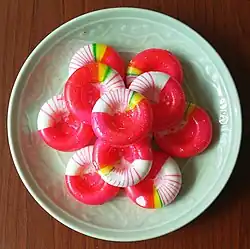Okchun-dang
 | |
| Alternative names | Okchun, saek-kusŭl-sathang |
|---|---|
| Type | Candy |
| Place of origin | Korea |
| Associated cuisine | Korean cuisine |
| Main ingredients | Rice flour |
| South Korean name | |
| Hangul | 옥춘당 |
| Hanja | 玉春糖 |
| RR | okchundang |
| MR | okch'undang |
| IPA | [ok̚.tɕʰun.daŋ] |
| Alternate name | |
| Hangul | 옥춘 |
| Hanja | 玉春 |
| RR | okchun |
| MR | okch'un |
| IPA | [ok̚.tɕʰun] |
| North Korean name | |
| Hangul | 색구슬사탕 |
| Hanja | 色구슬沙糖 |
| RR | saekguseulsatang |
| MR | saekkusŭlsat'ang |
| IPA | [sɛk̚.k͈u.sɯl.sa.tʰaŋ] |
Okchun-dang (Korean: 옥춘당; Hanja: 玉春糖) or okchun (옥춘; 玉春),[1][2] called saek-kusŭl-sathang (색구슬사탕; "colour marble candy") in North Korea,[3] is a traditional Korean sweet made of rice flour. The flat, rounded sweet is red with white, yellow and green decoration.
It is a staple on the table for various traditional ceremonies such as jesa (ancestral rite) and hwangap (60th birthday).[2]
Gallery
-
 (the left-most stack in the photo) okchun-dang piled high on the table at a celebration of hwangap
(the left-most stack in the photo) okchun-dang piled high on the table at a celebration of hwangap
References
- ^ "Okchun-dang" 옥춘당. Standard Korean Language Dictionary (in Korean). National Institute of Korean Language. Archived from the original on 7 February 2017. Retrieved 6 February 2017.
- ^ a b "Okchun-dang" 옥춘당. Doopedia (in Korean). Doosan Corporation. Retrieved 6 February 2017.
- ^ "Saek-guseul-satang" 색구슬사탕. Standard Korean Language Dictionary (in Korean). National Institute of Korean Language. Archived from the original on 7 February 2017. Retrieved 6 February 2017.